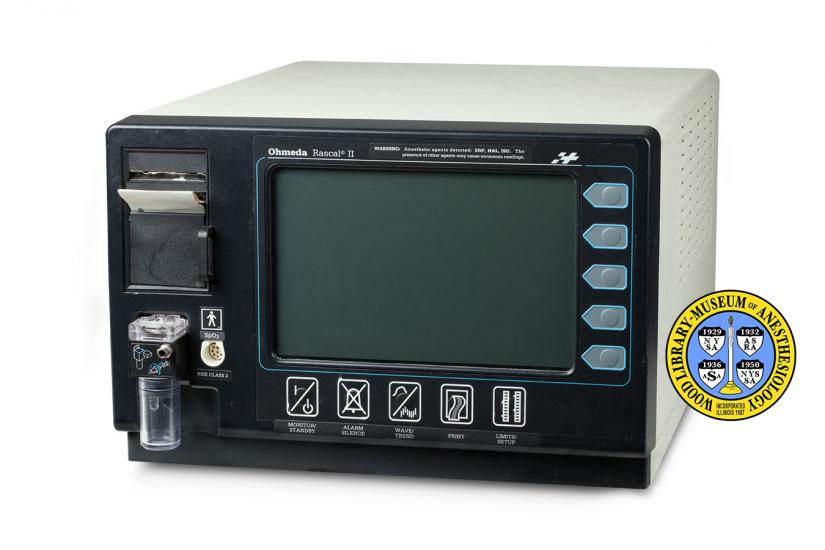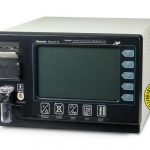Rascal II
The Indian physicist, Sir Chandrasekhara V. Raman (1888-1970), had a life-long interest in optics. In 1930, he won the Nobel Prize in Physics for his discovery that scattered light can reveal the molecular contents of gases and other substances. Unlike mass spectroscopy, “Raman scattering” can identify and measure all anesthetic and respiratory gases. It was first put to use for anesthesiology in the Rascal I monitor, introduced in 1986 by Albion Instruments. The Rascal II, shown here, was made by Ohmeda from 1993 through 1998. Both used a high-intensity laser to produce the scattered light. Both earlier and later agent monitors used infrared light for this purpose.
In the 1990s, five inhalation anesthetics were in common use: halothane, enflurane, isoflurane, sevoflurane and desflurane. The Rascal II could analyze any three of these, at the choice of the purchaser. It continuously sampled the air and gases both inhaled and exhaled by the patient, identifying the individual gases present and their concentration. This information was displayed on a screen, as numerical values, graphs and waveforms. It could also be printed on a strip of paper. Anesthesiologists use this information to monitor the patient’s condition, and adjust the amounts of anesthetic and oxygen they administer, as needed.
Catalog Record: Rascal II
Access Key: akwj
Accession No.: 2002-03-20-1
Title: Ohmeda rascal II.
Corporate Author: Ohmeda.
Title variation: Alt Title
Title: Rascal II monitor.
Publisher: Salt Lake City, UT : Ohmeda, [1992].
Physical Descript: 1 monitoring device : metals, plastics, rubber, glass ; 25 x 36 x 57 cm.
Subject: Monitoring, Intraoperative – instrumentation.
Subject: Monitoring, Physiologic – instrumentation.
Subject: Anesthetics – analysis.
Subject: Enflurane.
Subject: Isoflurane.
Subject: Halothane.
Note Type: General
Notes: Date of manufacture is based on the date written on a sticker that was
applied to the back of the device. The Rascal II was not distributed until
1994 (Lockwood, 1994).
Note Type: With
Notes: The cords and tubing that are bundled together and plugged into the back of
the device were not measured; They were not photographed with the device.
Note Type: Citation
Notes: Anesthesia gas monitoring: evolution of a defacto standard of care. Masimo
Corporation website. https://www.masimo.
com/pdf/phasein/anesthesia-gas-monitoring-evolution-of-a-de-facto-standard-of
care.pdf. Published by ProMed Strategies, 2009. Accessed August 10, 2014.
Note Type: Citation
Notes: Jaffe MB. Brief history of time and volumetric capnography. In: Gravenstein
JS, Jaffe MB, Gravenstein N, Paulus DA, eds. Capnography. 2nd ed. Cambridge:
Cambridge University Press; 2011:423-426.
Note Type: Citation
Notes: Lawson D, Samanta S, Magee PT, Gregonis DE. Stability and long-term
durability of Raman spectroscopy. J Clin Monit. 1993;9(4):241-251.
Note Type: Citation
Notes: Lockwood GG, Landon MK, Chakrabarti MK, Whitwam JG. The Ohmeda Rascal II: a
new gas analyser for anaesthetic use. Anaesthesia. 1994;49(1):44-53.
Note Type: Citation
Notes: Sadhasivam S, Lai D. Blue skies forever: the enduring legacy of Sir C.V.
Ramen and the origins of the Ohmeda Rascal II Bull Anesth Hist. January,
2004;22(1):9-11. https://ahahq.org/Bulletin/January_2004.pdf. Accessed August
7, 2014.
Note Type: Physical Description
Notes: One anesthetic agent monitor, rectangular in shape; The side, top and bottom
are an off-white color ; Most of the operational controls are located in the
front of the device, which is black with mostly white lettering; A display
screen in located on the right, upper side of the front of the device; To the
right of the screen are unlabeled pointer shaped buttons used to indicate
menu choices displayed on the screen; Below the screen are five rectangular
buttons with symbols to indicate their function; Text is printed below each
button: “MONITOR/STANDBY”, “ALARM SILENCE”, “WAVE/TREND”, “PRINT”, and
“LIMITS/SETUP”; Printed above the screen is, “Ohmeda Rascal II” and “WARNING:
Anesthetic agents detected: ENF, HAL, ISO. The [new line] presence of other
agents may cause erroneous readings”; In the upper left of the front of the
device is a printer, and in the left lower front of the device is a port to
connect a probe for pulse oximetry; This port is labeled “SpO2”; To the right
of the pulse dosimeter port is the gas inlet; On the back of the device the
on/off switch and main power socket are located in the lower right side; Just
below these is located a cylinder that once contained argon; The cylinder is
painted white; The paint is chipped; Also located on the right is the sample
exhaust port; Two vents are located in about the middle of the back; On the
upper left of the back is serial communications port with five long
connections plugged into it; The connections are each labeled; The labels are
“AGGNT”, “N2”, “O2”, “N2O”, and “CO2”; To the right of this port and plug is
a metal plate with the following markings, “Standard”, “C22.2 No. 125”, “2G
RISK CLASS”, and “PTO in Canada 5-1044″; A white sticker with the following
text is also located on the back: “Model 00800-09811”, “Serial No. FZAV00647”
and “Manufactured Aug, 1992”; Other manufacturer markings on the back of the
device include: “Ohmeda [new line] 4745 Wiley Post Way [new line] Salt Lake
City, UT 84116 [new line] A Division of BOC Health Care, Inc. [new line] Made
in USA”, “Voltage and current Ratings 100V-1220V-50/60 Hz 2.5A”, “This
product complies with 21CFR 1040.10 and 1040.11 requirements for a Class I
laser product.”, “Pat. 4,784,488″, and “ETL Testing Laboratories Inc. [new
line] Cortland, New York 13045”.
Note Type: Historical
Notes: Anesthetic gas monitors measure the concentrations of anesthetic gases in the
air being breathed by patients during anesthesia. During the 1980s when the
use of such monitors was growing, most of them measured anesthetic gas
concentration with mass spectrometry. The Rascal, short for Raman Scattering
Analyzer, measured gas concentration using Raman scattering. The physicist C.
V. Raman discovered the phenomenon in India in 1928.
When a beam of light hits the molecules of a gas, the molecules absorb some
of the light’s energy. This changes the light in a specific way for each gas.
The Rascal monitor measured these changes.
The Rascal and its successor, the Rascal II, could measure concentrations of
up to three anesthetic gases, as well as oxygen, carbon dioxide, nitrogen,
and nitrous oxide. The three anesthetic agents to be monitored were chosen
during the purchase process from five options: halothane, enflurane,
isoflurane, sevoflurane, and desflurane. The monitor described here was
configured for enflurane, halothane and sevoflurane.
The Rascal was designed by scientists at the University of Utah, and
introduced in 1986. In 1990 Ohmeda acquired the original manufacturer, Albion
Instruments, and in 1994 began to distribute the Rascal II. Production of the
Rascal II ceased in 1998, after instruments that used infrared spectrometry
became more popular.
Note Type: Reproduction
Notes: Photographed by Mr. Steve Donisch, September 17, 2013.
Note Type: Exhibition
Notes: Selected for the WLM website.


